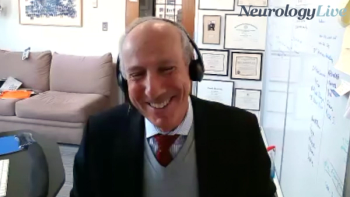
NDA for Diazepam Buccal Film Accepted by FDA for Seizure Cluster Treatment
The Aquestive Therapeutics diazepam formulation is seeking to be second to market in the treatment of seizure clusters, with a targeted prescription drug user fee action date of September 27, 2020.
Keith J. Kendall
The FDA has accepted a new drug application (NDA) for Aquestive Therapeutics’
The agency has declared a targeted prescription drug user fee (PDUFA) action date of September 27, 2020. Recently, in data presented at the
“The FDA filing acceptance for Libervant is an important milestone in our mission to provide epilepsy patients with a broader array of treatment options, that represent major contributions to patient care,” said Keith J. Kendall, chief executive officer, Aquestive, said in a statement. “Aquestive is committed to helping people affected by seizure clusters through bringing important and innovative products to the market. Epilepsy patients have been underserved for some time with little choice beyond device-based products such as rectally administered gels and nasal sprays.”
“We believe that our drug candidate Libervant will, if approved by the FDA, represent a major contribution to patient care, as compared to available treatment options, and further expand patient choice as the first orally administered dosage form available to manage seizure clusters in epilepsy patients,” he continued.
In the single-dose crossover study (NCT03953820), adult patients aged 18 to 65 years with epilepsy who were on a stable regimen of ≥1 antiepileptic drug were randomly assigned to receive a single dose of either diazepam buccal film or diazepam rectal gel separated by a 28-day washout period. Both were administered according to a weight-based regimen—dose range: 12.5-17.5 mg for buccal film; 12.5-20 mg for rectal gel for 51-111 kg.2
READ MORE:
In total, 28 patients were included in the final analysis, receiving mean doses of 15.4± -1.9 mg of the diazepam buccal film and 17.1± -3.0 mg of the rectal gel. Mean Cmax values for the buccal film were 204.26 ng/mL compared with 211.22 ng/mL in the rectal gel group, demonstrating comparable but less variable Cmax values with diazepam buccal film versus rectal gel (P <.0001). Across the different weight categories, mean maximal plasma concentration (Cmax) values were consistently 150 ng/mL in the buccal film group.
AUC values were greater for diazepam buccal film compared to rectal gel, and the median time to Cmax values were 1.0 and 0.52 hour for buccal film versus rectal gel, respectively (P <.05). Notably, 3 patients assigned to diazepam rectal gel failed to achieve a Cmax of ³70 ng/mL; no serious adverse events (AEs) were recorded.
“One of the goals of rescue therapy is to treat seizure clusters, recognized as medical emergencies, before negative consequences may be experienced,” said Jacqueline A. French, professor of neurology, Comprehensive Epilepsy Center, NYU Langone Health, and chief medical & innovation officer, Epilepsy Foundation. “These consequences may include injury and seizure progression to status epilepticus. Having a seizure rescue treatment that is generally safe, reliable and ready-to-use is very empowering. We encourage all epilepsy patients to work with their doctors to make sure they have a seizure rescue treatment plan in place.”
The second study presented at AES was an ongoing, phase 3 safety and tolerability trial (NCT03428360), in which patients aged 2 to 65 years were received diazepam buccal film doses ranging from 5 mg to 17.5 mg. Doses were administered at home by the patient or a caregiver, and could be given for up to 5 seizure episodes per month.3
Results of that analyses included data from 72 patients (adults, n = 59; adolescents, n = 7; pediatric, n = 6). Overall, 6.9% (n = 5) of patients reported 7 mild treatment-related AEs over a mean of 192 days of follow-up, with 1 patient reporting mild local buccal discomfort. Thirteen serious, but non-treatment-related AEs were reported; however, no patients discontinued participation due to AEs. The most common treatment-related AEs were somnolence, lethargy, altered state of consciousness, mouth swelling, oral discomfort, gait disturbance, and skin sensitization (all n = 1).
Just last month, the
“The FDA has recently indicated that, when evaluating clinical superiority for drugs demonstrating a ‘major contribution to patient care,’ it may consider such factors as convenience of treatment location, duration of treatment, patient comfort, reduced treatment burden, advanced in ease and comfort of drug administration, longer periods between doses, and potential for self-administration,” Kendall said.
REFERENCES
1. Aquestive Therapeutics Announces U.S. Food and Drug Administration Filing Acceptance of New Drug Application (NDA) for Libervant™ (diazepam) Buccal Film [press release]. Warren, NJ: Aquestive Therapeutics; Published February 10, 2020. finance.yahoo.com/news/aquestive-therapeutics-announces-u-food-120010825.html. Accessed February 11, 2020.
2. Seinfeld S, Gelfand M, Heller AH, Buan C, Slatko G. Safety and tolerability associated with chronic intermittent use of diazepam buccal film in pediatric, adolescent, and adult patients with epilepsy. Presented at: 2019 American Epilepsy Society Annual Meeting. December 6-10, 2019; Baltimore, MD. Abstract 3.444.
3. Rogawski MA, Heller AH, Farrow S, et al. Pharmacokinetics of diazepam buccal film in adult patients with epilepsy: comparison with diazepam rectal gel. Presented at: 2019 American Epilepsy Society Annual Meeting. December 6-10, 2019; Baltimore, MD. Abstract 1.432.
4. Neurelis Announces FDA Approval for Seizure Rescue Treatment VALTOCO® (Diazepam Nasal Spray) that Incorporates the Science of Intravail® for Consistent and Reliable Absorption [news release]. San Diego, CA: Neurelis Inc. January 13, 2020. prnewswire.com/news-releases/neurelis-announces-fda-approval-for-seizure-rescue-treatment-valtoco-diazepam-nasal-spray-that-incorporates-the-science-of-intravail-for-consistent-and-reliable-absorption-300985345.html. Accessed February 11, 2020.
Newsletter
Keep your finger on the pulse of neurology—subscribe to NeurologyLive for expert interviews, new data, and breakthrough treatment updates.



































